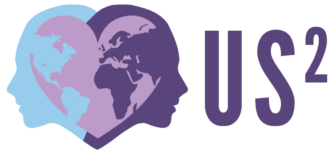In a world that champions diversity and inclusion, it’s time to explore the complexities of sizeism, unravel its damage and impact, and discover the power of empathy and understanding. Together, we’ll pave the way to a more equitable society where everyone is valued for their uniqueness, not their appearance.
Sizeism Defined
Sizeism. You might not have heard this term every day, but it’s a challenge that many individuals face. At US², we define sizeism as the prejudice and discrimination that society places on people based on their actual or perceived body size or shape.
In a world that is becoming more inclusive, sizeism still thrives. People of all shapes and sizes find themselves feeling the pressure of societal expectations and stereotypes. You’re not alone if you’ve ever felt the weight of these judgments or the pressure to conform to a narrow definition of size and beauty. We know that the stigma is heavy; at US², every issue counts!
Now, let’s take a deeper view into understanding sizeism so we can start understanding how it works.
Sizeism, In a Nutshell
As defined, sizeism is discrimination or prejudice directed toward individuals based on their body size. If you’ve ever thought about a baby being large for their age, what are some of the other thoughts that come with that? Some of those thoughts may be rooted in sizeism. Recognizing those thoughts is the first step!
More than Just Appearance
Sizeism goes beyond aesthetics. It extends to assumptions about a person’s character, health, and abilities solely based on their size. Many people in larger bodies are judged and stereotyped before they can get into a meeting or interview. Opportunities open when we can see beyond size.
The Thin Ideal
In many Western societies, a pervasive “thin ideal” is predominant. Being thin is desirable and superior, leading to discrimination against those who don’t conform. What if we could redefine beauty on our terms, embracing diversity?
Today, we’re unlocking the door to empathy and awareness. By recognizing the challenge, empathizing with those who face it, and grasping the opportunity to redefine beauty and worth, we can start dismantling the harmful effects of sizeism. Let’s embrace this opportunity to change the narrative and build a more inclusive world where everyone is valued for their uniqueness.
Hidden in Plain Sight: The Nature of Sizeism
We’ve thoroughly defined sizeism, so the next step is understanding how it manifests in our lives and society.
As we venture further, remember that you’re not alone in facing sizeism.
People from all walks of life grapple with sizeism and how it impacts the way we treat other people. Whether it’s internalized and you are battling with self-esteem, or unintentionally perpetuating sizeist ideals, there are many of us who don’t notice sizeism and how it impacts us daily.
As we unravel the layers of sizeism, we shed light on its damaging effects and work towards a more inclusive society. But what is the nature of sizeism, and why is it such a challenge?
Sizeism’s Subtle Nature
Sizeism often operates subtly, making it challenging to identify. It’s not always as overt as other forms of discrimination, but its consequences can be just as profound. Sizeism has many different names: “diet culture” for example, is one way that sizeism shows up. Think of the times when seemingly innocent comments or media messages have left you feeling self-conscious about your body size.
Media Influence
The media plays a significant role in perpetuating sizeism by promoting unrealistic body standards. Sizeism and diet culture lead to a cycle of comparison – can you recall instances when media images made you question your self-worth? Media and social media have given us a window to society in ways that can perpetuate sizeism and continue this cycle.
Intersectionality
Sizeism can intersect with other forms of discrimination, such as racism and sexism, amplifying its negative effects for those who hold intersecting marginalizations. This complex web of biases can create significant challenges and compound the mental health wellness for people at those intersections.
Exploring the nature of sizeism is taking a step toward a more empathetic and informed society. We’re creating the opportunity to recognize the subtle ways in which sizeism operates, empowering us to challenge it and support those affected.
Assumptions & Stereotypes
Preconceived notions, assumptions, and stereotypes can be as hurtful as they are inaccurate, adding another layer to the challenge faced by those who don’t conform to society’s narrow beauty standards. As we continue to unravel this complex web, let’s remind ourselves that the challenges of sizeism are shared by many. From assumptions about health to judgments about self-control, countless individuals navigate these societal biases on a daily basis.
Here’s the opportunity: by confronting and dismantling these stereotypes, we can create a more empathetic and inclusive society.
So, what are these stereotypes, and how do they contribute to the challenge of sizeism? And, if you’ve got some extra courage available, which of these assumptions have you made? We encourage guilt-free exploration here!
Health Is More Than a Number
One stereotype linked to sizeism is the assumption that larger individuals are inherently unhealthy. However, health is a complex and multifaceted aspect of an individual’s life. This stereotype overlooks the holistic factors that contribute to one’s well-being, from genetics to environment. Health is an overview of many factors and cannot be measured by a scale.
Lack of Self-Control
Sizeism often unfairly presumes that larger individuals lack self-discipline or control. Yet, this bias doesn’t consider the countless individuals who make daily efforts to lead balanced and healthy lives while facing societal judgments.
Limited Opportunities
Larger individuals may encounter societal assumptions that they are less competent or less worthy of opportunities. But in reality, talent, intelligence, and capability know no size.
We can break free from these harmful assumptions and build a world that values people for their qualities, talents, and potential, rather than their appearance. Let’s seize this opportunity to defy stereotypes, challenge sizeism, and embrace a society where everyone is recognized for their unique strengths. By challenging these stereotypes, we create an opportunity to promote empathy, understanding, and support for individuals of all body sizes.
As we wrap up this exploration into sizeism, we’ve uncovered a valuable opportunity. We’ve learned that sizeism impacts countless individuals, leading to discrimination based on body size. However, we’ve also learned that by understanding sizeism and how it works, we have the power to create a world where individuals are valued for their unique qualities, abilities, and potential rather than their appearance. We can build a society that’s more empathetic, inclusive, and accepting of people of all body sizes.
Our transformation continues in the next blog post, “Self-Reflection: Recognizing Sizeism Within,” where we’ll explore the new challenge of recognizing sizeism in ourselves. It’s an essential step in evolution. By becoming aware of our own biases and behaviors, we can take meaningful action to stand against sizeism both within us and in the world around us.
Join Our Newsletter
If you’re passionate about promoting social justice, equity, diversity, and inclusion, don’t miss out on our newsletter. Sign up today and be part of the change we wish to see and to get tools to make your own change happen!
Together, we can make the world a more accepting and inclusive place for everyone, regardless of their body size! Thank you for joining us. Let’s keep the conversation going, and let’s keep making a difference, one step at a time.




